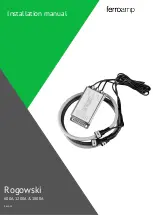
1-17
1-77.
High Reflected Power Release Signal.
A reflected power release signal is controlled by
AND gate U38A. When condition causing the high forward/reflected power condition is
removed, a HIGH operate signal, a HIGH 1.2 : 1 VSWR signal from comparator U66C,
and a HIGH from latch U67A will be ANDed at U38A. U38A will respond by routing a
HIGH reflected power release signal to priority encoder U28. U28 will respond by
routing a binary number to multiplexer U27. U27 will respond by selecting a clock signal
from integrated circuit U26. U26 is a divider designed to generate several clock signals.
The clock signals are used to drive the power control circuit up/down counters up as
determined by the type of release signal applied to U28. For example, a high reflected
power release condition selects a 2 Hz clock signal. The 2 Hz clock signal from U27 is
applied to up/down counters U30/U31. U30/U31 will respond by counting up and routing
binary numbers to digital-to-analog converter U42. U42 will respond by routing an
increased voltage reference to U43. U43 will output an increased reference voltage to
increase the transmitter output power.
1-78.
Over-Temperature Recovery.
When the condition which caused the over-temperature
problem is removed, the transmitter will initiate a recovery sequence.
The output of
comparator U65A will go LOW. The LOW is applied to AND gate U51D. With a HIGH
enable failure signal, U51D will output a LOW to terminate the over-temperature attack
signal.
1-79.
When the temperature is reduced to approximately 55 degrees C, the output of
comparator U65B will go HIGH. The HIGH is applied to AND gate U47D. With the
HIGH from latch U67C, U47D will output a HIGH over-temperature release signal to
priority encoder U28. U28 will respond by routing a binary number to multiplexer U27.
U27 will respond by selecting a 1/16 Hz clock signal from integrated circuit U26. The
1/16 Hz clock signal from U27 is applied to up/down counters U30/U31. U30/U31 will
respond by counting up and routing binary numbers to digital-to-analog converter U42.
U42 will respond by routing an increased voltage reference to U43. U43 will output an
increased reference voltage to increase the transmitter output power.
1-80.
Reflected Power Emergency/Lightning Recovery.
When the condition which caused the
reflected power emergency/lightning problem is removed, the transmitter will initiate a
recovery sequence.
The sequence is initiated by comparator U65D. U65D compares a fast
reflected power voltage sample to a reference voltage. When the sample voltage is below
the reference, the output of U65D will go HIGH. The HIGH is applied to AND gate
U71A. With a HIGH from latch U67B, U71A will output a fast foldback release signal to
priority encoder U28. U28 will respond by routing a binary number to multiplexer U27.
U27 will respond by selecting a 512 Hz clock signal from integrated circuit U26. The 512
Hz clock signal from U27 is applied to up/down counters U30/U31. U30/U31 will respond
by counting up and routing binary numbers to digital-to-analog converter U42. U42 will
respond by routing an increased voltage reference to U43. U43 will output an increased
reference voltage to increase the transmitter output power.
1-81.
In addition to the sequence initiated by U65D, a HIGH foldback reset command is applied
to transistor Q56. The HIGH biases Q56 on to unlatch OR gate U69C. U69C will output
a LOW to latch U49A to allow the latch to be reset.
1-82.
EXCITER MONITORING.
The operating condition of the exciter is monitored by a exciter
status circuit. During an exciter fault condition, the exciter fault status input will go
HIGH. The HIGH is applied to AND gate U36D. With a HIGH enable failure signal,
U36D will output a HIGH to latch U48A. U48A will output a HIGH to: 1) bias driver
transistor Q45 off to extinguish the exciter indicator green LED and 2) inverter U46A.
U46A will output a LOW to bias driver transistor Q44 on. This will illuminate the
exciter indicator red LED.
Summary of Contents for AM-2.5E
Page 11: ...1 2 FIGURE 1 1 AM 2 5E TRANSMITTER 597 1114 1 COPYRIGHT 1999 BROADCAST ELECTRONICS INC...
Page 12: ...1 3 COPYRIGHT 1999 BROADCAST ELECTRONICS INC 597 1114 2 FIGURE 1 2 AM 5E TRANSMITTER...
Page 40: ...2 24 FIGURE 2 11 AM 5E PRIMARY AC WIRING COPYRIGHT 1999 BROADCAST ELECTRONICS INC 597 1114 9...
Page 68: ...597 1114 5 FIGURE 4 1 AM 2 5E BLOCK DIAGRAM 4 3 4 4 COPYRIGHT 1999 BROADCAST ELECTRONICS INC...
Page 69: ...597 1114 4 FIGURE 4 2 AM 5E BLOCK DIAGRAM 4 5 4 6 COPYRIGHT 1999 BROADCAST ELECTRONICS INC...
Page 121: ......
Page 122: ......
Page 123: ......
Page 124: ......
Page 125: ......
Page 126: ......
Page 127: ......
Page 128: ......
Page 129: ......
Page 130: ......
Page 131: ......
Page 132: ......
Page 133: ......
Page 134: ......
Page 135: ......
Page 136: ......
Page 137: ......
Page 160: ......
Page 161: ......
Page 162: ......
Page 163: ......
Page 164: ......
Page 188: ......
Page 189: ......
Page 190: ......
Page 191: ......
Page 208: ......
Page 209: ......
Page 210: ......
Page 211: ......
Page 291: ......
Page 292: ......
Page 293: ......
Page 294: ......
Page 295: ......
Page 296: ......
Page 299: ......
Page 300: ......
Page 301: ......
Page 302: ......
Page 303: ......
Page 304: ......
Page 305: ......
Page 306: ......
Page 309: ......
Page 310: ......
Page 311: ......
Page 312: ......
Page 313: ......
Page 314: ......
Page 317: ......
Page 318: ......
Page 319: ......
Page 320: ......
















































